Symphony D.
Deity
The last time I ran a story, it didn't turn out quite the way I wanted. First of all, it didn't get finished in story form. Second, despite being called To Bring Enlightenment it ended in 1977 by Space Race Victory after about 20 years of thermonuclear hellfire. It taught me something though, and that's that pacifisim sucks, and fighting a war with no offensive units except ships and nukes isn't particularly effective. I wanted to do something different this time, something unique, and something hopefully challenging as well. I decided on a unique concept: how fun would it be to play a rogue state? Yes, that's right, no goody-goody world peace in this one, lets be unscrupulous and back-stabbing. At the same time I want to prepare myself for a jump up to Monarchy, so I've decided to put something together that shouldn't be too easy. So, without further blather, I present to you:
Carthage takes on the World!...Eventually!
Map Type: Large, Pangaea, 60% Water, Arid, Warm, 3 Billion Years, Roaming Barbarians
AI Type: 11x Random AI, Default Rules (minus Respawn AI), Regent, Normal Aggression
Player: Carthage
I suppose if I'd wanted to be masochistic I could've set it to Highest Aggression and Raging Barbarians, but that's retrospect for you. You're probably wondering "What the hell is this man thinking, playing a seafaring civ on a pangaea map?!" and you're probably right. It makes it a bit more difficult but it also plays into the general strategy I'm currently envisioning for the later half of the game. Industrious is good for my purposes too and I have a thing for the blood red civ color. So I generated a few maps until I got the first one that was at least servicable, and the story began from there. Just a warning, this part moves pretty slow, but it should pick up speed pretty quickly as things start really happening. Hope you enjoy it if you press on.
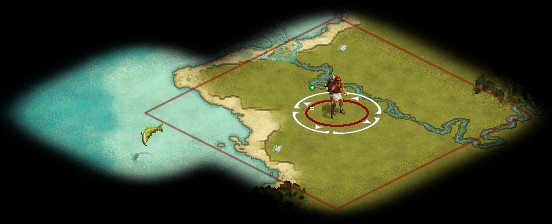
The people who would one day be know as Carthaginians had lived upon the Plain of Tunis - bisected by a great, which was know simply as "Great River" - since time immemorial. They were not so much a people as groups of individuals speaking the same language clustered in small gatherings of huts near one another. Infighting was constant, life was cheap, and dying was easy. This changed, at least somewhat, one day when a man named Hannibal turned what was in truth an inconsequential victory against a neighboring village into what was seemingly a great victory through what would today be called propaganda. Bestowing upon himself the title of General and rallying the people to his supposed great leadership, he banded the small villages together and pooled their resources along the Great River, forming a city. This city was to be called Carthage, and the people were to have a new name, taken from this glorious new paradigm of civilization: Carthaginians.
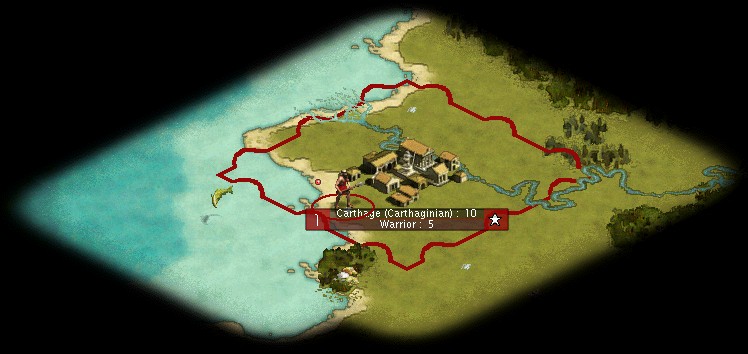
Carthage itself was built at a unique position, at place where the Great River and Great Sea beyond its delta were both within fairly easy reach of one location. The land around the city was fertile, and while not exceptional, good enough for the early needs of such a people. Perhaps the most interesting aspect of Carthage's location was that scouts reported there were groves of Spice-bearing plants due South of the city. Hannibal and his newly formed group of Advisors, the Council of Six, all recognized it would be in their best interests to find a way to get these Spices to Carthage, for it would pacify the people and keep them from challenging the regime's rule. The Trade Advisor especially recommended this, but the other Advisors were not so agreeable over what else the new city should do. The Military Advisor demanded a combat force be raised for defense, while the Science Advisor was seemingly distraught with the myriad array of possible ideas he and his fellow Sooth-Sayers might explore. A compromise was agreed to: the group of Workers the Trade Advisor had organized would built improvements toward the Spices, the Military Advisor would work to organize a group of Warriors to defend Carthage, and the Science Advisor would find a way to put thoughts and words into permanent form to facilitate further though - sadly he was given a very small amount of resources to do this with (Study Writing, 10% Research).
It took many years to combine the pre-city fighting techniques and hunting skills of the Carthaginians into a set of rudimentary combat tactics, but the results were ultimately successful, and soon a group of the best Warriors Carthage had to offer was formed. Above the objections of the Military Advisor, whose words have been lost to time but were something to the effect of "You're nucking futs!", the Warriors were sent East along the Great River to explore for new lands and peoples rather than defend the city. At about this time, the first great effort of the Carthaginians to bend the earth to their will bore fruit, as a mine was constructed Southwest of Carthage. Despite - or perhaps due to - the enormous effort put into this undertaking, few could imagine it would be the first of a countless number of such constructions.
The exploration along the Great River continued for quite some time, until eventually an interesting thing was discovered: it split.
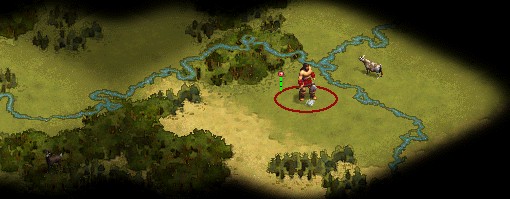
There were also abundent cattle in the region of the split. It is believed the art of barbeque was discovered by the Carthaginians sometime around this point. Faced with a dilemma, the expedition decided to take the Northern branch, and sent back runners with word that the Southern branch should be explored by a second party sometime soon. Such an opportunity would not take much of a wait as the second expeditionary force of Warriors (the Military Advisor was only further enraged that they too would not be used for defense) was organized shortly after the news arrived. However, due to either leader inexperience or perhaps possible intoxication - historical sources are unclear - the second group immediately headed Southeast rather than East along the Great River.
Meanwhile, the first group, having continued to navigate upstream on the Northern Great River, finally encountered a people at least somewhat comparable to themselves - the Thracians. The Thracian people were friendly and gave the Carthaginian envoys maps detailing the regions surrounding their village.
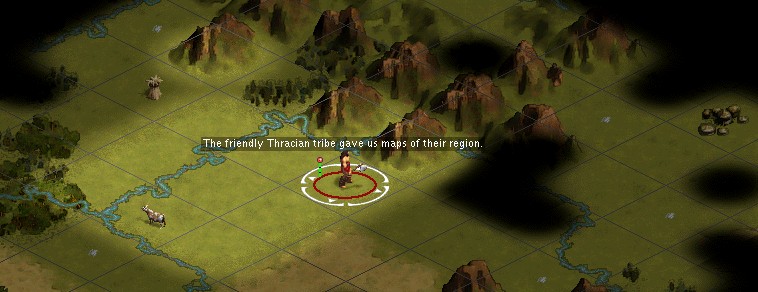
The maps themselves were well detailed but not of much practical use - despite Carthage's expanding influence these regions were still well outside of its current capability for expansion. They did show a fertile landscape however, and there was the promise of good sights for further settlements sometime in the future. What really interested the leader of the Warrior party was the presence of another village of the Thracian maps, and he and his men immediately set about to meet these new people. At around the same time, records indicate a rather eccentric individual living on the banks of the Great Sea - his name has been lost to us - managed to convince several locals to join him on a strange floating craft for what he called "a great adventure" - they would have no idea how great. In Carthage proper, efforts also began on organizing a group of settlers who would go and found another city, similar to Carthage, elsewhere upon the fertile Plain of Tunis.
While the endeavor of organizing such a party was occuring, the Workers of Carthage finally managed to connect a road to the Spices in the South, and the people of Carthage rejoiced as the first loads of such goods entered their city. Hannibal and the Council of Six felt sure that the people would not question their authority for some time with such goods. All the while during preparations for colonization the first Warrior group was advancing on the new, unknown village, having little idea what they might encounter. Upon finally reaching their destination, there were shocked by what they discovered.
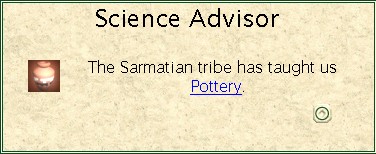
These seeming primitives had knowledge of something advanced beyond the Carthaginians themselves! Although upon seeing such things, some of the Warriors could not understand how no one in Carthage had ever thought of making a clay pot before, this new invention was eagerly adopted from the friendly Samaritans.
Elsewhere, to the South, the second expeditionary group, despite having a green commander, being drunk, or perhaps having a drunk green commander, managed to encounter a group similar to the Thracians who called themselves Illuyrians, and also had maps to share.
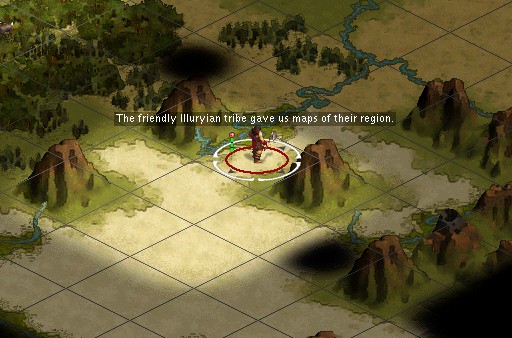
The maps showed the South to be dry and a place of sifting sands and rock, dubbed the Zearm Desert, while in the East there were giant mountains - even one which spewed fire! Strangely enough to the North it revealed a tributary to the South Great River. Perhaps the commander wasn't so foolish after all. The second Warrior group continued in a Southeastern direction, exploring around the mountains and desert, while their counterparts in the first group eventually discovered coast due North of the Samaritan village. The unsanctioned group under the guidance of the eccentric coast-dweller also reported something odd: there were mountains at the coast South of the second group.
Sometime after these landmark exploratory events, just as the first Carthaginian settler party was preparing to venture from the city, a strange thing happened. A man named Toynbee entered the city, carrying with him an odd tome. At first the guards thought he might be a spy of some kind for some foreign power, though they had never encountered anyone more advanced than the Samaritans, but he said he was merely a "theologian" and demanded to be taken to see their leader. Upon meeting with Hannibal and the Council of Six, he revealed the contents of his book to them.
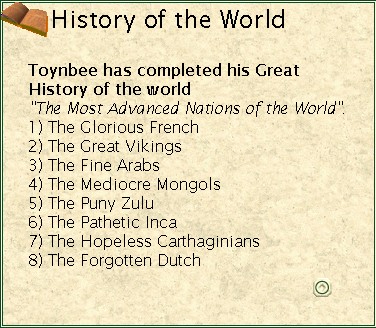
Although the Scientific Advisor balked at the idea the Carthaginians couldn't be the most advanced nation in all of existence, Hannibal was more curious - and weary. Who were all these oddly named people, and where were they?
Carthage takes on the World!...Eventually!
Map Type: Large, Pangaea, 60% Water, Arid, Warm, 3 Billion Years, Roaming Barbarians
AI Type: 11x Random AI, Default Rules (minus Respawn AI), Regent, Normal Aggression
Player: Carthage
I suppose if I'd wanted to be masochistic I could've set it to Highest Aggression and Raging Barbarians, but that's retrospect for you. You're probably wondering "What the hell is this man thinking, playing a seafaring civ on a pangaea map?!" and you're probably right. It makes it a bit more difficult but it also plays into the general strategy I'm currently envisioning for the later half of the game. Industrious is good for my purposes too and I have a thing for the blood red civ color. So I generated a few maps until I got the first one that was at least servicable, and the story began from there. Just a warning, this part moves pretty slow, but it should pick up speed pretty quickly as things start really happening. Hope you enjoy it if you press on.
The people who would one day be know as Carthaginians had lived upon the Plain of Tunis - bisected by a great, which was know simply as "Great River" - since time immemorial. They were not so much a people as groups of individuals speaking the same language clustered in small gatherings of huts near one another. Infighting was constant, life was cheap, and dying was easy. This changed, at least somewhat, one day when a man named Hannibal turned what was in truth an inconsequential victory against a neighboring village into what was seemingly a great victory through what would today be called propaganda. Bestowing upon himself the title of General and rallying the people to his supposed great leadership, he banded the small villages together and pooled their resources along the Great River, forming a city. This city was to be called Carthage, and the people were to have a new name, taken from this glorious new paradigm of civilization: Carthaginians.
Carthage itself was built at a unique position, at place where the Great River and Great Sea beyond its delta were both within fairly easy reach of one location. The land around the city was fertile, and while not exceptional, good enough for the early needs of such a people. Perhaps the most interesting aspect of Carthage's location was that scouts reported there were groves of Spice-bearing plants due South of the city. Hannibal and his newly formed group of Advisors, the Council of Six, all recognized it would be in their best interests to find a way to get these Spices to Carthage, for it would pacify the people and keep them from challenging the regime's rule. The Trade Advisor especially recommended this, but the other Advisors were not so agreeable over what else the new city should do. The Military Advisor demanded a combat force be raised for defense, while the Science Advisor was seemingly distraught with the myriad array of possible ideas he and his fellow Sooth-Sayers might explore. A compromise was agreed to: the group of Workers the Trade Advisor had organized would built improvements toward the Spices, the Military Advisor would work to organize a group of Warriors to defend Carthage, and the Science Advisor would find a way to put thoughts and words into permanent form to facilitate further though - sadly he was given a very small amount of resources to do this with (Study Writing, 10% Research).
It took many years to combine the pre-city fighting techniques and hunting skills of the Carthaginians into a set of rudimentary combat tactics, but the results were ultimately successful, and soon a group of the best Warriors Carthage had to offer was formed. Above the objections of the Military Advisor, whose words have been lost to time but were something to the effect of "You're nucking futs!", the Warriors were sent East along the Great River to explore for new lands and peoples rather than defend the city. At about this time, the first great effort of the Carthaginians to bend the earth to their will bore fruit, as a mine was constructed Southwest of Carthage. Despite - or perhaps due to - the enormous effort put into this undertaking, few could imagine it would be the first of a countless number of such constructions.
The exploration along the Great River continued for quite some time, until eventually an interesting thing was discovered: it split.
There were also abundent cattle in the region of the split. It is believed the art of barbeque was discovered by the Carthaginians sometime around this point. Faced with a dilemma, the expedition decided to take the Northern branch, and sent back runners with word that the Southern branch should be explored by a second party sometime soon. Such an opportunity would not take much of a wait as the second expeditionary force of Warriors (the Military Advisor was only further enraged that they too would not be used for defense) was organized shortly after the news arrived. However, due to either leader inexperience or perhaps possible intoxication - historical sources are unclear - the second group immediately headed Southeast rather than East along the Great River.
Meanwhile, the first group, having continued to navigate upstream on the Northern Great River, finally encountered a people at least somewhat comparable to themselves - the Thracians. The Thracian people were friendly and gave the Carthaginian envoys maps detailing the regions surrounding their village.
The maps themselves were well detailed but not of much practical use - despite Carthage's expanding influence these regions were still well outside of its current capability for expansion. They did show a fertile landscape however, and there was the promise of good sights for further settlements sometime in the future. What really interested the leader of the Warrior party was the presence of another village of the Thracian maps, and he and his men immediately set about to meet these new people. At around the same time, records indicate a rather eccentric individual living on the banks of the Great Sea - his name has been lost to us - managed to convince several locals to join him on a strange floating craft for what he called "a great adventure" - they would have no idea how great. In Carthage proper, efforts also began on organizing a group of settlers who would go and found another city, similar to Carthage, elsewhere upon the fertile Plain of Tunis.
While the endeavor of organizing such a party was occuring, the Workers of Carthage finally managed to connect a road to the Spices in the South, and the people of Carthage rejoiced as the first loads of such goods entered their city. Hannibal and the Council of Six felt sure that the people would not question their authority for some time with such goods. All the while during preparations for colonization the first Warrior group was advancing on the new, unknown village, having little idea what they might encounter. Upon finally reaching their destination, there were shocked by what they discovered.
These seeming primitives had knowledge of something advanced beyond the Carthaginians themselves! Although upon seeing such things, some of the Warriors could not understand how no one in Carthage had ever thought of making a clay pot before, this new invention was eagerly adopted from the friendly Samaritans.
Elsewhere, to the South, the second expeditionary group, despite having a green commander, being drunk, or perhaps having a drunk green commander, managed to encounter a group similar to the Thracians who called themselves Illuyrians, and also had maps to share.
The maps showed the South to be dry and a place of sifting sands and rock, dubbed the Zearm Desert, while in the East there were giant mountains - even one which spewed fire! Strangely enough to the North it revealed a tributary to the South Great River. Perhaps the commander wasn't so foolish after all. The second Warrior group continued in a Southeastern direction, exploring around the mountains and desert, while their counterparts in the first group eventually discovered coast due North of the Samaritan village. The unsanctioned group under the guidance of the eccentric coast-dweller also reported something odd: there were mountains at the coast South of the second group.
Sometime after these landmark exploratory events, just as the first Carthaginian settler party was preparing to venture from the city, a strange thing happened. A man named Toynbee entered the city, carrying with him an odd tome. At first the guards thought he might be a spy of some kind for some foreign power, though they had never encountered anyone more advanced than the Samaritans, but he said he was merely a "theologian" and demanded to be taken to see their leader. Upon meeting with Hannibal and the Council of Six, he revealed the contents of his book to them.
Although the Scientific Advisor balked at the idea the Carthaginians couldn't be the most advanced nation in all of existence, Hannibal was more curious - and weary. Who were all these oddly named people, and where were they?



 (his screens were the inspiration for the idea).
(his screens were the inspiration for the idea). I'm sure something more advanced like Photoshop or PSP can do something similar pretty easily.
I'm sure something more advanced like Photoshop or PSP can do something similar pretty easily. I have to rush off to a class soon but I'll post some updates later today.
I have to rush off to a class soon but I'll post some updates later today. .
. yes you did
yes you did 